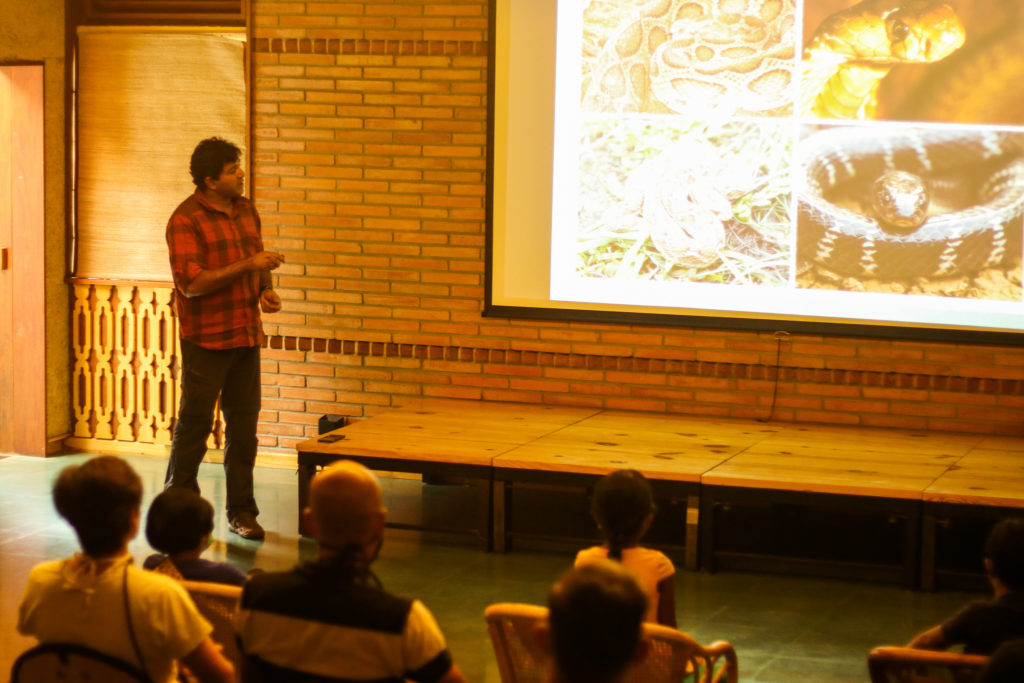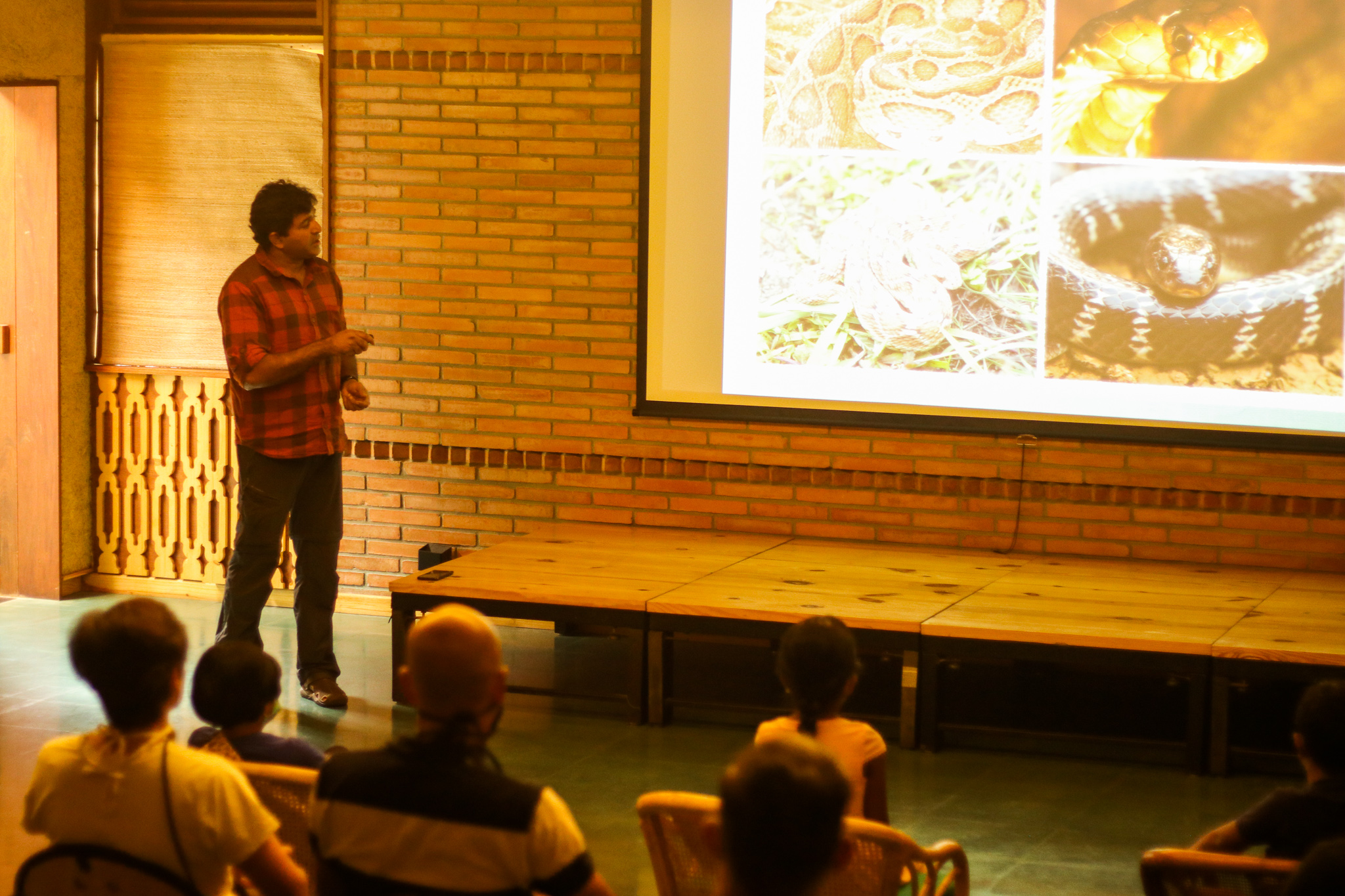The World Below
Snakes and Snakebite in India with Gerry Martin
Week 3 kick-started its first session with Gerry Martin asking the question “What is a Snake?” in his talk – Snakes and Snakebite in India. He kept the entire audience engaged with an extremely interesting presentation interspersed with an unforgettable sense of humor.
Addressing several misconceptions about snakes, Gerry explained how 300 species of snakes live in India, and quite contrary to public belief, are more inclined to live in the city than in the jungle. He also pointed out that there are a lot of supernatural beliefs when it comes to snakes, which is often inaccurate. It was interesting to hear one of the myths associated with the Red Sand Boa, where there is a belief that it brings money to a household when sold and for this reason the snakes were artificially made heavier using cruel methods.
One of the most important aspects of the talk was the de-stigmatization of snakes. In fact, throughout the presentation, Gerry never once referred to snakes as a “problem”. He emphasized how a lot of our fears related to snakes are due to the stigma associated with them, and how as long as we don’t trouble a snake, it won’t attack us. His comic relief timing was at its best – “Snakes don’t care about us. If we weren’t safe, there wouldn’t be 1.3 billion Indians!”
The delightful talk covered a range of topics including varieties of snakes, how to handle a snake bite, stigmas associated with snakes, anti-venom research and much more and ended with an interactive Q & A session.

Snake Awareness at Malhar – Satish, Prithvi, Prakruthi and Sreenandhan /Malhar Snake group – Multilingual
The meet on Saturday included two sessions on Snake Awareness at Malhar, by Satish Sukumar, Prithvi Raj, Prakruthi Subramanya and Sreenandhan. The Malhar Snake Group shared some of their experiences with snakes and the different types of snakes they had seen around Malhar. This session was split into two parts – one, in English, was for the Malhar residents and the other, in Kannada, was for the staff at Malhar.
The sessions focused on the different characteristics of various snakes, such as the appearance and sensory capabilities, heat pits, etc. The speakers shed light on the snakes commonly seen around Malhar such as the Spectacled Cobra, Russell’s Viper, Common Krait, Saw Scale Viper, Indian Rat Snake, Striped Keelback, Checkered Keelback, Trinket Snake, Vine Snake, Indian Wolf Snake, Kukri, and many more.
The talks also focused on the trends around Malhar, where they elaborated on when we are most likely to spot a snake and even addressed how to handle a snake bite and the precautions to take if a snake enters a house.
They emphasized the fact that we don’t have to take any drastic measures on spotting a snake and that we can coexist with snakes, and in the words on Satish Sukumar – “We can learn to coexist with these creatures, after all it’s their home too.”
The session was very informative and relevant to both the residents and the staff. In the words of Sagar Jena, a staff member at Malhar, “hum log ko pata nahi hota hain ke kaunsa saamp jehere hain aur konsa nahi hain, yahan jo training diya hain humko, sabko bohot acha laga” (we don’t know which snake is poisonous and which isn’t, so we really enjoyed the training here).

Understanding Insects through Crochet with Sandhya Srinvasan
Understanding ‘Insects through Crochet’ with Sandhya Srinvasan was an interesting and exciting session, where people were taught the art of making insects by crochet.
Sandhya described how there are different types of crochet, and the style she likes to use is Amigurumi, a “Japanese toy making style”. She explained how “Ami” means “knitted” and “Kurumi” means “wrapping”. Amigurumi can be crocheted out of yarn or thread, using the basic techniques of crochet (such as single crochet stitch , double crochet, invisible decrease). Amigurumi can be worked in sections which are crocheted together. In crochet, Amigurumi are typically worked in spiral rounds to prevent “striping”, a typical feature of joining crochet rounds in a piece.
The session was very interactive and was hosted in the beautiful outdoor space at Courtyard Koota. There were 12 attendees, including a few kids and the session was very engaging. Sandhya also brought some crochet toys that she had made including a spider, a bee, a ladybug, and other colorful insects that immediately had the attention of the entire audience.

Wild Malhar Diaries – Butterflies – Manmath Acharjya
Wild Malhar Diaries – Butterflies, was a short talk by Manmath Acharjya. This talk was the opening act of the evening and really set the tone for the feature talk.
Mammath spoke about butterflies and explained how there are six categories of them. Referring to it as “Learning by Chance”, he also spoke about his journey through studying these beautiful creatures.
The short talk was packed with information, engaging the whole audience with questions such as “What is the difference between a Butterfly and a Moth?” The crowd was given tips on how to spot these creatures and explained how moths are typically harder to spot, and on how to approach a butterfly/moth emphasizing that it is important to not hold/capture them as it can harm the delicate creatures.
Manmath has an incredible collection of images he had taken of his sightings, and had divided this gallery into 2 sections, one for butterflies and the other for moths. The colorful presentation had everyone’s attention and was a great start to the rest of the evening.

From soup to superstar: the making of a marine icon in India – Kartik Shanker
Saturday’s Keynote was Kartik Shanker’s talk on Sea Turtles – From Soup to Superstar. Filled with tons of little anecdotes, the talk was extremely entertaining and informative.
Kartik started the talk relating his journey through tracking the leatherback turtle, paying tribute to his mentors, Lemin and Whitaker. He also spoke about the various adventures of his friends Satish (‘the turtleman’ as they called him) and Agu in the Andaman and Nicobar islands.
As a part of his journey, the speaker also reminisced about his initial study of turtles in the Andaman and Nicobar islands and the unfortunate loss of a lot of people and resources during the tsunami that interrupted it. He mentioned that there are about 7 species of turtles, and described how they used transmitters to track the path of the turtles during the course of his study.
He noted that post mechanization, a total of 50,000 – 80,000 turtles were caught per year and talked about Vijaya, India’s first woman herpetologist, and her efforts to solve this problem. He also mentioned that Vijaya’s campaign and article were referenced in India Today in 1982.
“Turtles are Flagships” – he concluded. This session was captivating to say the least, and the speaker effortlessly commanded the undivided attention of the audience with his humor and style.

Nature Walk with Chayant and Nanu
By popular demand, there was a second Nature Walk with Chayant and Nanu. The walk started from Malhar Tarana at 6:45 AM and everyone were eager to spot various birds around the area. Karnataka, as a result of its climate and greenery has several different hot spots for birding such as Nandi Hills and Bannerghatta forest ranges, and Malhar is definitely one of them.
The walk was mostly behind Resonance, because as Chayant pointed out – that although Malhar has over 130 species of birds, a lot of them stay around the border, behind the community. The weather was extremely pleasant and there were about 20 folks who joined the adventure.
The refreshing outdoor activity lasted till about 9 AM and the enthusiastic group spotted close to 39 different species of birds.

The Smaller Majority by Shyamal
The week closed with an incredibly insightful session by Shyamal who effortlessly brought the attention of the audience to the whole new world of insects. “We look at them as a negative thing, I wanted to try to appreciate what we usually don’t think about twice” was the opening sentence of his talk and surely he did educate the audience on how intricate and interesting the world of insects can be.
He started the talk with the different phases the earth went through chronologically and explained how insects adapted to survive in each phase, and emphasized their ability to adapt with the words – “one of the most successful organisms in this period are insects, based on their ability to live anywhere and feed on anything”.
Shyamal explained how living beings aren’t only limited to animals and plants but actually can be categorized into 3 domains. He also talked about the evolution of insects starting from one of the oldest and most primary species – the silverfish. Shedding light on the physical processes of insects, such as moulting and metamorphosis, he went on to explain the different stages within the lifespan of an insect and touched on other interesting topics such as the difference between a damselfly and dragonfly.
In addition to presenting facts about insects, he also described how insects can actually be helpful to life on earth and are actually very smart in their approach towards evolution, predation and other aspects of their life. It was a perfect ending to our third weekend – the world below.







Previous
Next


Courtyard Koota is a lifetime gift to us. Big thank you to the team for your continued efforts to enrich us and our next gen. Cheers, Maj Guru